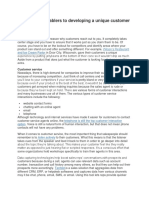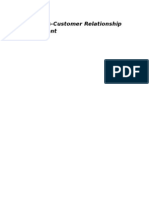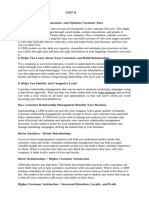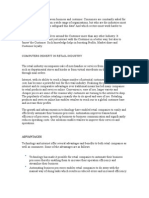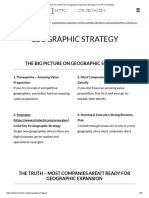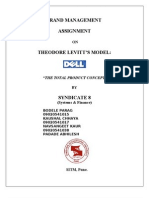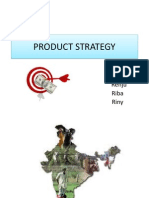0 ratings0% found this document useful (0 votes)
16 viewsC C C CCCC CC C CCCCCC CC C CC CCCCC C
C C C CCCC CC C CCCCCC CC C CC CCCCC C
Uploaded by
Lucypriya JenaThe document discusses customer relationship management (CRM) systems and how they are used to provide effective customer service. CRM systems incorporate call handling, sales tracking, and transaction support using tools like call centers, data mining of customer information from cookies and web logs. The document also outlines five stages in the loyalty life cycle that customers progress through - from awareness to exploration to familiarity, commitment, and finally separation. It notes the importance of segmentationg customers by life cycle stage to better develop relationships with customers over time.
Copyright:
Attribution Non-Commercial (BY-NC)
Available Formats
Download as DOCX, PDF, TXT or read online from Scribd
C C C CCCC CC C CCCCCC CC C CC CCCCC C
C C C CCCC CC C CCCCCC CC C CC CCCCC C
Uploaded by
Lucypriya Jena0 ratings0% found this document useful (0 votes)
16 views5 pagesThe document discusses customer relationship management (CRM) systems and how they are used to provide effective customer service. CRM systems incorporate call handling, sales tracking, and transaction support using tools like call centers, data mining of customer information from cookies and web logs. The document also outlines five stages in the loyalty life cycle that customers progress through - from awareness to exploration to familiarity, commitment, and finally separation. It notes the importance of segmentationg customers by life cycle stage to better develop relationships with customers over time.
Original Title
Crm
Copyright
© Attribution Non-Commercial (BY-NC)
Available Formats
DOCX, PDF, TXT or read online from Scribd
Share this document
Did you find this document useful?
Is this content inappropriate?
The document discusses customer relationship management (CRM) systems and how they are used to provide effective customer service. CRM systems incorporate call handling, sales tracking, and transaction support using tools like call centers, data mining of customer information from cookies and web logs. The document also outlines five stages in the loyalty life cycle that customers progress through - from awareness to exploration to familiarity, commitment, and finally separation. It notes the importance of segmentationg customers by life cycle stage to better develop relationships with customers over time.
Copyright:
Attribution Non-Commercial (BY-NC)
Available Formats
Download as DOCX, PDF, TXT or read online from Scribd
Download as docx, pdf, or txt
0 ratings0% found this document useful (0 votes)
16 views5 pagesC C C CCCC CC C CCCCCC CC C CC CCCCC C
C C C CCCC CC C CCCCCC CC C CC CCCCC C
Uploaded by
Lucypriya JenaThe document discusses customer relationship management (CRM) systems and how they are used to provide effective customer service. CRM systems incorporate call handling, sales tracking, and transaction support using tools like call centers, data mining of customer information from cookies and web logs. The document also outlines five stages in the loyalty life cycle that customers progress through - from awareness to exploration to familiarity, commitment, and finally separation. It notes the importance of segmentationg customers by life cycle stage to better develop relationships with customers over time.
Copyright:
Attribution Non-Commercial (BY-NC)
Available Formats
Download as DOCX, PDF, TXT or read online from Scribd
Download as docx, pdf, or txt
You are on page 1of 5
the sum of a company’s customer service solutions
constitutes its customer relationship management (CRM)
system. Level of traffic at the online business site and the
available resources would normally determine whether or
not a business should have CRM. It provides fast and
effective service to customers and ensures that corrective
measures are readily in place. CRM includes call handling,
sales tracking and Transaction support
(technology/personnel etc.). Three tools can be used to
improve customer service, that is, log file analysis, cookies
and data mining. Under CRM system, call centers can be set
up having customer service representatives who can be
reached trough phone, e-mails or online chatting. There are
software tools or tracking devices that can provide feedback
on how many number of internet users actually viewed a
banner or a marketing message and how many actually
clicked on the advertisement. Log files consist of data
generated by site visits and include information about each
visitor’s location, IP address, time of visit, frequency of visits
etc. There are businesses that provide the services of
analyzing web log files. The results would show how effective
your web site is and indicate the top-referring web sites. You
know that cookies allow e-commerce sites to record visitor
behavior. They can be used to track customers online and do
personalization. Many customers do not know that their
information is being collected and used by the ebusiness site.
Thus, informational privacy rights of customers can be
breached in cases where cookies are used. One major goal of
CRM is to establish a long-lasting relationship between a
company and its customers. Good customer services can help
in building a sense of loyalty towards company and its
products or services. Experts have pointed out five stages of
loyalty as customer relationships develop over a period of
time. One can find that the intensity of relationship increases
as the customer moves through the first four stages. In the
fifth stage a decline occurs and the relationship terminates.
Awareness
This is the first stage where customers recognize the name of
the company or any of its products. However, they have
never interacted with the company before. A
company/business can achieve this level by properly
advertising its brand.
Exploration
At the exploration stage the potential customers know more
about the company or its products. For instance, they may
have visited the web site of the company and have
exchanged any information with it.
Page # 137
Familiarity
At this stage, customers have completed several business
transactions with the company and know its policies
regarding refund, privacy of information, discounts etc.
Commitment
Having completed a number of satisfactory transactions,
some customers may have developed a strong sense of
loyalty or preference for the products or brand of a company.
They are said to be at the commitment stage in their
relationship with a business. Such loyal customers often tell
others about their satisfaction as regards products/services
offered by the company. Sometimes, companies make
concessions on price or other terms of business to bring
customers into this stage.
Separation
After a period of time those conditions over which a valuable
customer relationship is established might change.
Customers might not be any longer satisfied with the product
quality or customer service. On the other hand, a company
may also find that a loyal customer is proving to be very
expensive to maintain. Thus, the parties enter into the
separation stage. Note that the objective of any marketing
strategy is to bring the customers quickly to the committed
stage and try to hold them there as long as possible.
Life Cycle Segmentation
These five stages are also called customer life cycle. Using
them to create groups of customers is called customer life-
cycle segmentation. Segment information is useful for
companies to develop better relationship with the
customers. Companies, thus, know about their customers
and their level of relationship with the company, and can
customize their product/service.
B2B Marketing on the Web
For effective CRM, it is necessary that there is complete
integration between different steps in a customer
transaction. So, the processes of selling, buying, marketing,
front-end and back-end operations should be fully linked and
integrated with each other. Key difference between B2C and
B2B is that in case of B2B there is no direct contact with the
end users, whereas this contact exists in B2C. Thus, an e-
business can have direct response or feedback from its
customers in B2C as compared to B2B. For example, an
online business that deals in the supply of raw material to an
online manufacturing business has a very limited chance of
receiving direct feedback from end customers about its
product/services due to lack of contact with them. That is
one reason why a marketing plan is different in B2B from
B2C.
Search Engines
A search engine is a program that scans web sites and forms
a list of relevant sites based on keywords or other search-
engines ranking criteria. It allows people to find information
about their area of interest out of large amount of
information available on the internet. Examples of famous e-
businesses that provide search engine facilities are google,
altavista, yahoo etc. As a marketer, after you have launched
your e-commerce web site, you should look for the
registration of the same with popular search engines so that
your site appears on search engine results.
You might also like
- Customer Relationship Management-Notes-Unit IDocument30 pagesCustomer Relationship Management-Notes-Unit Ifathimathabasum84% (38)
- Principle of Marketing Individual AssignmentDocument26 pagesPrinciple of Marketing Individual AssignmentHawe Mesfin100% (3)
- 3cd87what Is The Scope of CRMDocument6 pages3cd87what Is The Scope of CRManashussain100% (1)
- Reaction Paper ChristineDocument4 pagesReaction Paper ChristineOlivia NemirNo ratings yet
- What Are The Enablers To Developing A Unique Customer Experience?Document3 pagesWhat Are The Enablers To Developing A Unique Customer Experience?debmatraNo ratings yet
- What Are The Enablers To Developing A Unique Customer Experience?Document3 pagesWhat Are The Enablers To Developing A Unique Customer Experience?debmatraNo ratings yet
- What Are The Enablers To Developing A Unique Customer Experience?Document3 pagesWhat Are The Enablers To Developing A Unique Customer Experience?debmatraNo ratings yet
- Summary Chapter 8 "Customer Relationship Management"Document2 pagesSummary Chapter 8 "Customer Relationship Management"Aziz Putra AkbarNo ratings yet
- Ere PortDocument7 pagesEre PortPayal SharmaNo ratings yet
- CH 14 CSR: Review QuestionsDocument6 pagesCH 14 CSR: Review Questionsshahin317100% (2)
- Customer Relationship Marketing: To inspire good customer service behaviour, we must be able to measure customer experiences meaningfully.From EverandCustomer Relationship Marketing: To inspire good customer service behaviour, we must be able to measure customer experiences meaningfully.No ratings yet
- 2nd Ass - CRMDocument64 pages2nd Ass - CRMPersonal LoansNo ratings yet
- The Ladder of LoyaltyDocument7 pagesThe Ladder of Loyaltyguru110100% (1)
- Strategic ManagementDocument4 pagesStrategic Managementlunawat811No ratings yet
- CRM Tutorial - MCADocument46 pagesCRM Tutorial - MCAPankaj P Raibagkar JainNo ratings yet
- Customer Equity Management, Customer Value Analysis, Loyalty Monitoring, and Customer SatisfactionDocument3 pagesCustomer Equity Management, Customer Value Analysis, Loyalty Monitoring, and Customer SatisfactionshailendraNo ratings yet
- Effective Customer Relationship Management ThesisDocument5 pagesEffective Customer Relationship Management Thesisqfsimwvff100% (1)
- What Is Relationship MarketingDocument3 pagesWhat Is Relationship MarketingHairiya KhanNo ratings yet
- Unit - I: Relationship MarketingDocument19 pagesUnit - I: Relationship MarketingMohitNo ratings yet
- Framework of CRMDocument10 pagesFramework of CRMsachin vermaNo ratings yet
- CRM - Group Three (Entrepreneurship)Document22 pagesCRM - Group Three (Entrepreneurship)AMINAT OWODUNNINo ratings yet
- The Basic Small Business Customer Relationship Management ModelDocument7 pagesThe Basic Small Business Customer Relationship Management ModelHemchand ChadaramNo ratings yet
- Faculty of Commerce Tourism and Hospitality Management: Individual Assignment e Commerce BM 138 Rumbidzai Dzinzi R198686yDocument6 pagesFaculty of Commerce Tourism and Hospitality Management: Individual Assignment e Commerce BM 138 Rumbidzai Dzinzi R198686yRUMBIDZAI MELLISA DZINZINo ratings yet
- CRM - Customer Relationship Management: Enterprise DatabaseDocument8 pagesCRM - Customer Relationship Management: Enterprise Databaseconfidential86No ratings yet
- Customer Experience Makeover A Practical Approach To Competitively Differentiated ServiceDocument10 pagesCustomer Experience Makeover A Practical Approach To Competitively Differentiated ServicehkdashinNo ratings yet
- CRM1Document23 pagesCRM1kandavelNo ratings yet
- Customer Relationship Management JUNE 2022Document12 pagesCustomer Relationship Management JUNE 2022Rajni KumariNo ratings yet
- Efc Customer Relationship ManagementDocument15 pagesEfc Customer Relationship ManagementctyvteNo ratings yet
- CRM Automobile IndustryDocument8 pagesCRM Automobile IndustryKashish MehtaNo ratings yet
- Customer Relationship ManagementDocument15 pagesCustomer Relationship ManagementTanoj PandeyNo ratings yet
- Customer Relationship ManagementDocument5 pagesCustomer Relationship ManagementRitoban MukhopadhyayNo ratings yet
- Customer Experience MakeoverDocument11 pagesCustomer Experience MakeoverWaqas AzizNo ratings yet
- Customer Relationship Management Thesis ProposalDocument8 pagesCustomer Relationship Management Thesis Proposalashleycornettneworleans100% (2)
- Customer Relationship Management Literature ReviewDocument7 pagesCustomer Relationship Management Literature Reviewc5qp53eeNo ratings yet
- C R M As A Strategic Marketing ToolDocument3 pagesC R M As A Strategic Marketing ToolAswin SivaramakrishnanNo ratings yet
- CRM Unit 2Document11 pagesCRM Unit 2varunkumarramathilagam3No ratings yet
- CRM PSDA - Reliance Fresh FINALDocument67 pagesCRM PSDA - Reliance Fresh FINALKreepa Chowrasia ABS, NoidaNo ratings yet
- CRM Customer Relationship Management: A.Ayesha SiddiquaDocument13 pagesCRM Customer Relationship Management: A.Ayesha SiddiquaMahesh KumarNo ratings yet
- Chapter - 1 Introduction To The TopicDocument45 pagesChapter - 1 Introduction To The Topickrishna bajaitNo ratings yet
- Customer Relationship Management BBDocument6 pagesCustomer Relationship Management BBVishal Singh JaswalNo ratings yet
- What Is Customer Relationship ManagementDocument6 pagesWhat Is Customer Relationship Managementsusmile7No ratings yet
- Customer Relationship Management (CRM) Is A ManagementDocument59 pagesCustomer Relationship Management (CRM) Is A Managementhi2sam007No ratings yet
- CRM 100 Marks ProjectDocument80 pagesCRM 100 Marks ProjectShivkumar IyerNo ratings yet
- Relationship MarketingDocument16 pagesRelationship MarketingVansh Raj Yadav100% (1)
- Customer Relationship Management-Notes-Unit IIIDocument10 pagesCustomer Relationship Management-Notes-Unit IIIfathimathabasum100% (1)
- T.karthick A Study On Customer Relationship Management in PDocument34 pagesT.karthick A Study On Customer Relationship Management in PeswariNo ratings yet
- Customer Relationship Management (CRM)Document8 pagesCustomer Relationship Management (CRM)Ayushi SavnerNo ratings yet
- Answer 1Document5 pagesAnswer 1priyankaNo ratings yet
- Customer Relationship Management: CRM EntailsDocument14 pagesCustomer Relationship Management: CRM EntailsTanoj PandeyNo ratings yet
- Lead and Site Map CreationDocument13 pagesLead and Site Map CreationKamaliNo ratings yet
- Allocation Rules For CRMDocument11 pagesAllocation Rules For CRMEkta VadgamaNo ratings yet
- Assignment For CRMDocument8 pagesAssignment For CRMarti25sharmaNo ratings yet
- Relationship MarketingDocument16 pagesRelationship MarketingAmmar SomrooNo ratings yet
- Customer Relationship Management Project ReportDocument19 pagesCustomer Relationship Management Project ReportLokesh Krishnan100% (1)
- Customer Relationship ManagementDocument22 pagesCustomer Relationship ManagementsourabhkhusNo ratings yet
- CRM PaperDocument31 pagesCRM PaperPratik SinghNo ratings yet
- AdvantagesDocument7 pagesAdvantagesDheerajNo ratings yet
- Understanding Customer Requirements: Principles of DesignDocument30 pagesUnderstanding Customer Requirements: Principles of DesignChandrachood SBNo ratings yet
- In Class Quiz Ite Demand Supply 2016Document1 pageIn Class Quiz Ite Demand Supply 2016TamaraNo ratings yet
- The Role of 4 Ps On Customer Satisfaction: A Case Study of Berhan Bank in HawassaDocument18 pagesThe Role of 4 Ps On Customer Satisfaction: A Case Study of Berhan Bank in Hawassawale nigateNo ratings yet
- Stoats Company: Strategic Operations Planning For StoatsDocument16 pagesStoats Company: Strategic Operations Planning For StoatsLong Live PakistanNo ratings yet
- Brand Questionnaire Fillable PDFDocument4 pagesBrand Questionnaire Fillable PDFOllie DesrochersNo ratings yet
- Clean Edge Razor Case AnalysisDocument6 pagesClean Edge Razor Case AnalysisMayukhBhattacharyaNo ratings yet
- District School Implementation Plan in Science S.Y. 2019-2020 The Excellency of All District/School: Palompon NHS Address: Palompon, LeyteDocument2 pagesDistrict School Implementation Plan in Science S.Y. 2019-2020 The Excellency of All District/School: Palompon NHS Address: Palompon, LeyteMI ANNo ratings yet
- Module 3 SCMDocument9 pagesModule 3 SCMKhai LaNo ratings yet
- How To Create Your Geographic Expansion Strategy - Free PPT TemplatesDocument20 pagesHow To Create Your Geographic Expansion Strategy - Free PPT TemplatesNguyễnVũHoàngTấnNo ratings yet
- Business Studies Notes: Chapter 1: Role of BusinessDocument48 pagesBusiness Studies Notes: Chapter 1: Role of BusinessLevon SanossianNo ratings yet
- WorkBook Unit 4Document5 pagesWorkBook Unit 4asheka campbellNo ratings yet
- Strategy Diamond ModelDocument11 pagesStrategy Diamond Modelbramanti setiadiNo ratings yet
- SWOT Analysis of Dabur IndiaDocument4 pagesSWOT Analysis of Dabur IndiamaverickmichelleNo ratings yet
- Brand Management - Theodore Levitt Model - Syndicate 8Document10 pagesBrand Management - Theodore Levitt Model - Syndicate 8kaushalchhaya100% (1)
- Applied Economics Module 3Document13 pagesApplied Economics Module 3Jiell Renon VigiliaNo ratings yet
- Fundamentals of Cost-Volume-Profit Analysis: Solutions To Review QuestionsDocument46 pagesFundamentals of Cost-Volume-Profit Analysis: Solutions To Review QuestionsZYna ChaRisse TabaranzaNo ratings yet
- Product Strategy: Avin Bittu Renju Riba RinyDocument60 pagesProduct Strategy: Avin Bittu Renju Riba RinyRiba K JohnNo ratings yet
- PyarDocument78 pagesPyarAryamanNo ratings yet
- VDpolitichalthought 59 May 2020Document18 pagesVDpolitichalthought 59 May 2020PaulHerreraNo ratings yet
- BBVA Compass: Marketing Resource Allocation: Ho Kim, Ph.D. Assistant Professor of MarketingDocument27 pagesBBVA Compass: Marketing Resource Allocation: Ho Kim, Ph.D. Assistant Professor of MarketingJoaquín Norambuena Escalona100% (1)
- Kit Kat Dagmar Approach..EditedDocument4 pagesKit Kat Dagmar Approach..EditedMaina PeterNo ratings yet
- Product Life Cycle and BCG MatrixDocument16 pagesProduct Life Cycle and BCG MatrixArnold OniaNo ratings yet
- Advertising Research - MJDocument28 pagesAdvertising Research - MJMuhammad Sameer Husain100% (1)
- Industrial Market SegmentationDocument5 pagesIndustrial Market SegmentationKhudadad NabizadaNo ratings yet
- Final Dissertation ReportDocument57 pagesFinal Dissertation ReportswavimanNo ratings yet
- Chapter 2 The Agribusiness EnterpriseDocument12 pagesChapter 2 The Agribusiness EnterpriseNgoni MukukuNo ratings yet
- Ever Bilena Cosmetic Direct Sales Case Study by Rivera and Chua PDFDocument15 pagesEver Bilena Cosmetic Direct Sales Case Study by Rivera and Chua PDFPrecious Mole Tipas ES AnnexNo ratings yet
- Case Study Inventory ManagementDocument8 pagesCase Study Inventory ManagementMohammad UmairNo ratings yet
- MM Probable Questions and AnswersDocument3 pagesMM Probable Questions and AnswersBisweswar DashNo ratings yet






